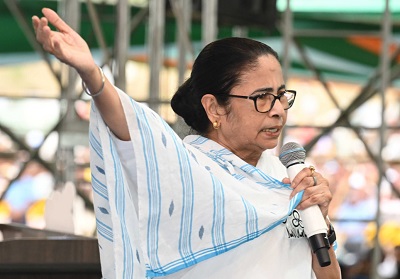Kolkata, (Asian independent) In the recent past whenever the central agency personnel are being attacked during their course of investigation in any case of irregularity in West Bengal, the common practice for the Trinamool Congress is to go in a direct counter-attack mode.
Now this direct counter-attack mode has two faces — political and legal. First the ruling party leadership led by Chief Minister Mamata Banerjee floats the two parallel narratives of “central conspiracy of unleashing central agencies” and “central agency sleuths provoking people.”
To complement these two political narratives, a section of those accused adopts the parallel legal initiatives by registering counter FIRs bringing serious charges against the central agency who have been actually attacked.
In such cases, the state police also initiate two parallel investigations on two parallel FIRs — the first on those registered by the attacked central agency and the second on the ones registered by a section of the accused.
In such a way the “counter blame game” takes a parallel dimension involving both political and legal perspectives.
The attack on ED sleuths at Sandeshkhali in North 24 Parganas district on January 5 and that on the NIA sleuths at Bhupatinagar in East Midnapore district on April 6 have striking resemblances.
In the case of Sandeshkhali, the Chief Minister, on the floor of the assembly accused the ED of “provoking” local people by deliberately targeting Trinamool Congress leader Sheikh Shahjahan, who is in ED custody now.
Simultaneously, one of the employees of Shahjahan filed a counter FIR at the local police station accusing the ED of unauthorised entry at the Shahjahan’s residence without any search warrant. The local police station initiated a parallel probe on that FIR besides the one filed by the attacked ED sleuths.
The same chronology was followed in the case of the attack on NIA sleuths at Bhupatinagar last week. The Chief Minister first accused the NIA sleuths of provoking the local people thereby harassing the local women in the name of raid operations.
A day after that the family members of one of the two TMC leaders arrested by NIA from Bhapatinagar, filed a counter-FIR against the central agency sleuths bringing serious allegations under Section 354 (punishment for outrage of modesty of women) of the IPC, which is a non-bailable offence.
This time too, the local police have started a probe on this counter FIR besides the one registered by the attacked NIA sleuths.
Now opening this “legal front” besides the “political attack” in such cases is something unique in West Bengal, which is not happening in other states where central agencies are resorting to actions and at times involving even Chief Ministers.
The political blame game accusing the Central government and BJP for unleashing central agencies is there as well. However, there has not been any reported counter-legal action targeting any central agency.
Political and legal observers feel that there is a well-thought-out strategy behind opening the parallel political and legal fronts in West Bengal. Since all the central agency probes in West Bengal, be it in the money laundering cases by ED or those started by NIA, such probes were started following the orders of the Calcutta High Court. In some cases, the probes were also court-monitored.
This was the area where exactly Trinamool Congress’s political logic of holding the Central government responsible for “vindictive politics” was falling flat, as the opposition leaders, mainly from the BJP camp, were highlighting the court orders for these probes as counter-arguments.
NIA said that the controversies surfacing over the raids at Bhupatinagar do not hold merit as the central agency probe, in this case, was also initiated following a Calcutta High Court order for the same.
This is exactly where the requirement of opening the parallel legal front surfaces, where the ruling party gets the opportunity for floating counter-narratives involving both the Central government and the central agencies.








